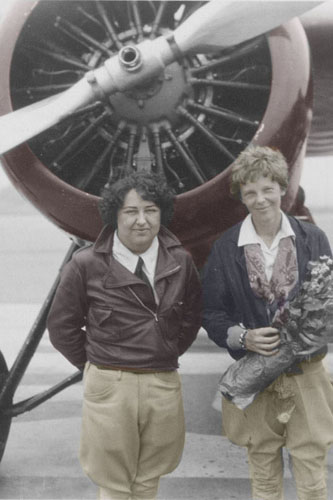
Pancho Barnes (left) and fellow aviatrix Amelia Earhart were both rivals and friends. Behind them is the Lockheed Vega Earhart flew in the 1929 “Powder Puff Derby,” a race that ended for Barnes when her airplane crashed in Waco, Texas.
By Clayton Moore
Strange things come out of the California desert, some curious enough to make you believe in ghosts, such as a new treasure trove of aviation artifacts recently discovered in the arid Mojave region. This discovery is featured in a bold new documentary that should finally cement the legend of one of America’s most flamboyant aviatrixes, Florence “Pancho” Barnes.
Most modern-day aviation buffs recall the rambunctious Barnes as the owner/barkeep of the Happy Bottom Riding Club, a name inspired by General Jimmy Doolittle, who claimed that riding one of her horses gave him a “happy bottom.”
The bar, airstrip and desert oasis near Edwards Air Force Base became a slice of American history that was memorably captured in the film “The Right Stuff.” True pioneers of American aviation, among them Doolittle and Bob Hoover, were known to tip a bottle at Barnes’ bar, as did engineers, officers and movie stars. Chuck Yeager cracked his ribs at Barnes’ ranch the day before his record-breaking supersonic flight in the X-1, and celebrated there after accomplishing the feat.
The years have been less kind to Barnes’ own flying record; few remember today that Florence Barnes was a pioneering pilot whose performance warrants its own historical consideration. The product of Pasadena high society, Barnes cut her own swath through the aviation world of the 1920s and 1930s, out-flying the best pilots of her generation and evolving into the brazen woman who famously declared, “Flying makes me feel like a sex maniac in a whorehouse.”
Produced by a team of professional filmmakers in partnership with public television station KOCE-TV of Orange County, Calif., the documentary, titled “Pancho Barnes!” promises an unrivaled examination of the life and legend of Pancho Barnes, and the broadcast of never before seen archival material. New interviews with famous friends such as Yeager and astronaut Buzz Aldrin are included, as well as revealing recollections by the original hostesses of the Happy Bottom Riding Club.
Its producer, Nick T. Spark, an enthusiastic student of aviation history who has written for Wings and Airpower magazines and the Journal of the American Aviation Historical Society, wrote the film. Spark is also a professional photographer and filmmaker in his own right who produced and directed a previous documentary, “Regulus,” about the first nuclear missile submarines.
“People know Pancho owned a bar at Edwards Air Force Base, but they don’t always know she was this famous aviatrix of the 1920s and 1930s,” Spark said. “We’re able to tell the story of Pancho Barnes and the story of flight itself through these incredible tales about her life. Anyone who’s interested in aviation is going to enjoy this movie. Women will find themselves inspired by the messages that it puts forth. Anyone that sees it will gain this very genuine sense of empowerment, because Pancho Barnes was all about doing the things you want to do and not letting anything stand in your way.”
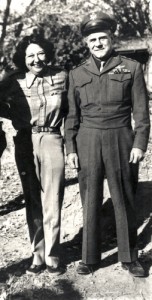
Gen. Jimmy Doolittle and Pancho Barnes were good friends. Doolittle gave the eulogy at her funeral in 1975.
A graduate of the prestigious film school at the University of Southern California, Spark went back to his alma mater to persuade one of his former teachers, Associate Professor Amanda Pope, to direct the movie. Pope coproduced “Wilbur and Orville: The First to Fly,” a wildly inventive 1973 drama starring Stacy and James Keach as the pioneering aviators. That film necessitated not only the building of working replicas of the Wrights’ famous aircraft but also the complete restoration of their bicycle shop to working condition.
“Amanda is fearless,” Spark declared. “I think she has a feistiness that’s important for a film about a very tough, feisty lady. It’s important to have someone conducting interviews who can remind people of the qualities that made Pancho different and how extraordinary it is to know someone that brave.”
Buried treasure
The project was first inspired when Spark pitched former Wings magazine editor-in-chief Mike Machat on a story about Barnes. Machat set the bar high, requiring that Spark come up with a completely fresh take.
Archival material about Barnes is patchy at best, although the famous pilot often appeared on the front pages of the city’s newspapers.
“I think she was somewhat infatuated with the media when she was younger,” Spark observed. “She was called ‘Our aviatrix’ by the Los Angeles Times. They certainly respected her as a ‘sky queen’ of the day. They loved her.”
Barnes participated in the 1929 “Powder Puff Derby” alongside Amelia Earhart, an achievement soon eclipsed by her subsequent record-breaking feats, including a 1930 flight in her Travel Air Model R “Mystery Ship,” which shattered Earhart’s record as the world’s fastest woman.
“Amelia Earhart got all the publicity and Bobbi Trout made all the money, but I was the best pilot,” Barnes said.
Unfortunately, Barnes’ later years were marked with numerous obstacles and grievous events. While she was engaged in a legal conflict with Edwards Air Force Base over a planned expansion, a suspicious fire burned down the Happy Bottom Riding Club, also known as the Rancho Oro Verde Fly-Inn Dude Ranch, on Nov. 13, 1953. Barnes told friends that she lost everything in the fire. She died in relative obscurity in 1975 at the age of 74.
In doing his research, Spark came across a dedicated enthusiast, Dr. Lou D’Elia, a former co-director of the neuropsychology assessment clinic at UCLA’s School of Medicine. By meeting D’Elia, Spark made a most remarkable discovery: when it comes to Pancho Barnes, the truth isn’t always what it seems.
D’Elia became interested in Barnes through his interest in Hollywood glamour photographer George Hurrell, who took several photos of Barnes in her decidedly masculine flight suits. Through a complex series of legal decisions, most of Barnes’ personal keepsakes wound up in the hands of her fourth and final ex-husband, Mac McKendry, who preserved it in a railroad car in the middle of the Mojave Desert. Once the ranch foreman at the Happy Bottom Riding Club, McKendry planned to open a museum about his late ex-wife but never got it off the ground. He died in 2001 at the age of 81.
“Three months prior, Lou made contact with the estate that owned all of Pancho Barnes’ personal materials,” Spark said. “He ended up purchasing everything.”
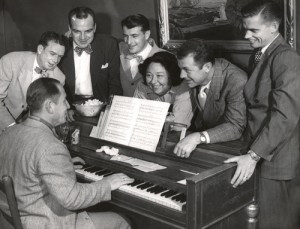
Pancho Barnes was a talented composer of tunes like “Song of the Air Force.” Here she tries out a new song with friends including Chuck Yeager (to her right), at the Happy Bottom Riding Club.
D’Elia took out a loan to purchase the entire collection from McKendry’s estate, managed by Dana Kilanowski, a director of the Flight Test Historical Society. D’Elia has since opened up an official site dedicated to the aviator under the umbrella of Pancho Barnes Enterprises, Inc., and calls the archives “a national treasure.” He plans to write a play based on the material he has purchased.
“When her ranch burned, she did lose a lot of memories,” Spark explained. “We’d never deny that fact. But I think that because she was involved with this big lawsuit against the government, she wanted to make her losses look as bad as she could.”
At D’Elia’s home, Spark felt privileged to open three of the 96 banker’s boxes from the Barnes archive.
“He opens this box up and the first thing he pulls out is this dusty guest register,” Spark recalled. “It was clearly the guest register of the Happy Bottom Riding Club. The first entry reads, ‘Pancho’s Place: Where Anything Can Happen and Usually Does,’ and it’s signed by Slick Goodlin.”
Chalmers “Slick” Goodlin, a civilian test pilot, flew the X-1 for a year, taking it to .8 Mach, before trying to renegotiate his contract—for $150,000. At that point, the Air Force gave the assignment to Chuck Yeager, who took the project through its goal of making the first supersonic flight, on Oct. 14, 1947, while receiving his standard military pay.
The guest register reads like a Who’s Who of aviation, ending just before Yeager’s famous flight. One of the last entries reads, “Supersonic days are here,” signed by Lockheed test pilot Tony LeVier.
On another occasion, D’Elia opened a box with Stephanie Barnes, the grand-grandniece of Florence Barnes. They discovered an unopened letter from Barnes to Roger Chute, her traveling companion on a trip through Mexico and the man who first dubbed her “Pancho.”
A host of other items found in the archives include Barnes’ personal “little black book,” with entries for silent film star Ramón Navarro and airplane designer Jack Northrop, and programs from Barnes’ annual rodeo, emblazoned with the logo of the Happy Bottom Riding Club. A 1951 telegram sends best wishes for happy holidays from aircraft designer and Bell Aircraft founder Larry Bell.
Even as a historical filmmaker, Spark is surprised at the depth of the rediscovered archive.
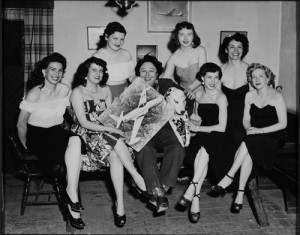
Pancho Barnes realized the pilots at Edwards Air Force base needed to blow off steam. She staffed her Happy Bottom Riding Club with attractive hostesses recruited from glamour studios in Los Angeles.
“Even with a person as famous as Jimmy Doolittle or Amelia Earhart, it would be unusual to discover a collection like this one,” Spark said. “Normally, a family would go through this kind of material and throw out the things they didn’t want people to see. Alternatively, they might simply dispose of things they thought were irrelevant but that might be momentous to a historian.”
Photographs of Yeager, Charles Lindbergh, early aviator Jimmie Wedell and other famous pilots were scattered throughout this remarkable collection.
“This is the extraordinary discovery that shows why we’re able to make this film,” Spark said. “In these 96 boxes were Pancho’s letters, her unfinished autobiography and an unbelievable amount of photographs. Most of the photos were in the form of negatives, so no one had even looked at the photographs themselves in nearly 70 years. We found one that almost certainly dates back to 1904. It had never been seen.”
Fact and fiction
Amanda Pope recalled being intrigued when Spark approached her with the material he had found.
“Stories like this come along once in a lifetime,” she said. “Any portrait of a woman who defied the popular conventions like Pancho Barnes and had so much fun doing it needs to be out in the public consciousness.”
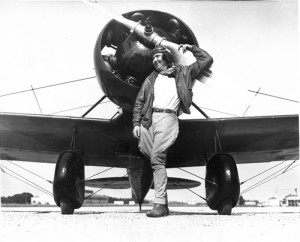
Pancho Barnes poses with her Travel Air Model R “Mystery Ship,” which broke Amelia Earheart’s speed record by hitting nearly 200 mph at Van Nuys Airport. Barnes paid over $13,000 for the plane, which was one of the fastest of its day.
From her participation on the Wright brothers’ film, Pope maintained an interest in the early days of aviation. She believes that Barnes’ earliest achievements are some of the most dramatic moments of her extraordinary life.
“Florence Barnes is front and center in the aviation world of the 1920s,” Pope said. “Think about the timing. Lindbergh flies across the Atlantic in 1925. Amelia Earhart crosses in 1928. Florence starts flying lessons in 1928, and two years later, she breaks Earhart’s speed record. From learning to fly to having that kind of mastery is an amazing accomplishments. You can’t just turn a switch and acquire that kind of expertise.”
Spark put his skills as a researcher to the test, delving through D’Elia’s archives and scouring libraries and other sources for original interviews and other source material, to both verify and augment the known stories about Barnes’ life.
“I knew, in terms of research, that it was going to be a huge hurdle,” he said. “A major challenge in the project is sorting out fact from fiction. I’ve discovered things I thought were true that are not true, and vice versa. We wanted the luxury of time to go out and really do the research, find Pancho’s friends, and show people something they had never seen before.”
The challenges of verifying the facts of Barnes’ life are rooted in her larger-than-life personality. As Chuck Yeager points out in the film, if someone started a rumor about her, Barnes often wouldn’t deny it.
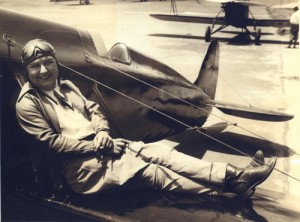
Pancho Barnes rests on the wing of her Travel Air Model R, which she later loaned to stunt pilot Paul Mantz for use in the movies.
One clarification concerned legendary humorist Will Rogers, who dubbed the first national women’s air race “The Power Puff Derby.” Because Barnes kept a photograph of Rogers and his friend Wiley Post on the wall of the Happy Bottom Riding Club, many assumed the pair had been friends. It was also rumored that Rogers’ fatal flight to Alaska in 1935 had originated at the Happy Bottom Riding Club. Spark’s thorough investigation, conducted with the help of the Will Rogers Memorial Archives, found no record of communications between Barnes and Rogers.
“It just affirms another aspect of her legacy, which is that people like to link her to the famous, but she’s very famous in her own right,” Spark said.
Much more substantial is the link between Pancho Barnes and Howard Hughes. Barnes worked extensively on reshoots for the eccentric multimillionaire’s film “Hell’s Angels,” flying her Travelair around balloons loaded with microphones to capture the throaty sound of her aircraft’s engine.
She subsequently became a stunt pilot in other Hollywood productions, but not for Hughes. Their relationship soured when she obstinately organized a stunt pilot’s union to guarantee her fellow pilots a living wage and safer working conditions.
“She and Hughes had a tough relationship, because she was one of the people who would stand up to him,” Spark observed. “She was like him in a lot of ways. They both came from fabulous wealth. They were both incredibly spoiled in some ways, and it evolved into a bit of a contest of wills between them.”
Pope agrees that the balance between verisimilitude and entertainment is one of a documentary filmmaker’s fundamental challenges.
“I don’t believe in sensationalizing a person,” the director said. “If you know your subject well enough, the truth is sensational enough. This is where Nick and I and our editor work together to create a structure that’s compelling without focusing on the more sensational aspects of Pancho’s life. There are people who want to make her a legend. We have to draw the line between what we know and what we don’t. The facts of her life are extraordinary by themselves.”
Finding Pancho’s voice
To capture the aviatrix’s colorful personality, Spark has composed his script for the documentary in a unique style that uses Barnes’ own words to augment the film’s portrait of her.
“We had an opportunity that you don’t get that often,” Spark said. “We had an unpublished autobiography, although it’s very incomplete. We had letters and court transcripts from her trial, and I found a number of interviews that were conducted with her late in her life. These things provided off-the-cuff quotes from her. She’s really a character, and we’re treating her presence as if we had interviewed her. She comes across as forceful, and she says such interesting things. It’s a door into a person’s life that most people assumed was shut long ago.”
The filmmakers are already narrowing a list of A-list Hollywood actresses to approach about performing Barnes’ role in the film.
“We see the same challenges with Pancho Barnes as documentarians have found about Eleanor Roosevelt, who had a very squeaky voice,” Pope explained. “Pancho’s voice wasn’t bad, per se, but it doesn’t really convey the person that she was. We’ll voice her own words, but we’ll do them with an actress or actresses who embody her fierce spirit.”
Going to the source
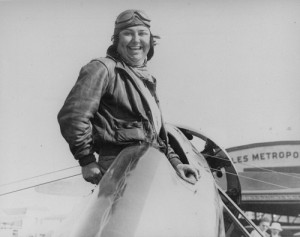
Pancho Barnes bought back her Travel Air Model R at the Tallmantz auction in 1968, after it was lost in Paul Mantz’ collection following his untimely death in a 1965 plane crash. After the crowd recognized her at the auction, no one bid against Barnes.
In addition to the complex work of restoring, cultivating and utilizing D’Elia’s archival material, the filmmakers also decided early on to conduct original interviews with the surviving friends and employees who remember what it was like to know Pancho Barnes.
In July 2007, Spark and Pope completed the extensive task of capturing 19 interviews with Barnes’ friends and acquaintances on film. Their subjects include Bob Hoover, Bob Cardenas, Chuck Yeager, Apollo 11 astronaut Buzz Aldrin, biographers Lauren Kessler and Barbara Schultz, Dr. D’Elia and Edwards Air Force Base historian Dr. Raymond Puffer.
“Amanda brought a lot of strengths to that part of the project,” Spark said. “When you sit down with someone like Bob Hoover or Chuck Yeager, it helps to have someone who understands the give and take involved in interviewing for film.”
Pope gained new insights into the wild and dangerous early years of the Cold War and felt moved by her interviews with the famous pilots.
“I was impressed with their courage and skill,” Pope recalled. “They have this extraordinary ability to improvise their lives. Increasingly in our own time, we’re going to have to learn to improvise our own lives because things are changing so fast. But these guys were improvising in the air at incredible speeds. They couldn’t give up. They had to keep going, and so their lives have changed enormously over the years.”

Hollywood glamour photographer George Hurrell took most of Pancho Barnes’ famous portraits He also shot her pilot’s license photo.
Among the technical challenges, Pope also faced the quandary of teasing out memories that capture the earthy and irreverent Barnes in her native environment.
“Bob Hoover is a consummate test pilot and a wonderfully outrageous guy,” Pope recalled. “These guys are larger than life, and yet, when they get in front of a woman, they can get very proper. That’s not who he is, and it’s not the person Pancho Barnes was. I had to circle around him, but he finally used his wonderful phrase: ‘We flew balls out.’ Pancho lived her life ‘balls out.’ And yet she was completely a woman.”
Barnes’ character is reflected in the words of the famous pilots who knew her and those of the ordinary men and women whose lives intersected with hers.
“Hoover and Yeager get asked about Pancho Barnes all the time, but a lot of the people we interviewed had never spoken on the record,” Spark revealed. “It was exciting to find some of these people and hear their stories.”
Irma “Babe” Story was a Women Airforce Service Pilots member during WWII. She learned to fly at the Happy Bottom Riding Club under the tutelage of Pancho Barnes. At the end of the instruction, the male certification inspector was horrified to find that the government had paid not for one but for two women to go through flight school at her encouragement. Left with no choice, the inspector took up Story and certified her to become a WASP.
Patrice Demory lived with Barnes and helped transcribe Barnes’ unfinished autobiography. Today, she often portrays Barnes’ grandmother, Leontine Lowe, at Civil War reenactments. Another source was Cowboy Hall of Fame member Tony King. Hired by Barnes when he was just a teenager, he eventually became foreman of her ranch.
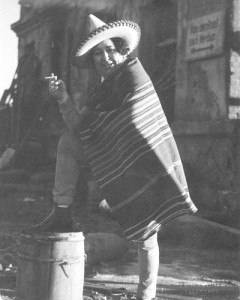
During a 1927 trip across Mexico, Roger Chute commented that his friend and traveling companion looked like “Pancho,” a mistaken reference to Don Quixote’s “Sancho Panza.” The name stuck.
“She was such an amazing woman,” Pope said. “Her generosity to people of all classes was extraordinary. Here she’d been brought up in this Edwardian climate of Pasadena and she’s making friends with the stable boy.”
“Dazzling” Dallas Morley has been an entertainer her whole life, but was once the head hostess of the Happy Bottom Riding Club, helping Barnes select girls to entertain their high-spirited guests.
“She has some of the most classic stories,” Sparks said of Morley. “She ended up at Pancho’s because she was hitchhiking and was picked up by a couple of guys who brought her to the club and bought her a meal. Pancho ended up hiring her and she became the head hostess. She had all the stories about who did what and what really happened—and didn’t happen—at the Happy Bottom Riding Club.”
While the club only lasted a short time in the scope of American aviation history, it was home to a remarkably diverse cast of characters.
“Pancho’s place was a real nexus between the worlds of aviation and Hollywood,” Sparks said. “You’d see a movie star at the bar and Larry Bell walking in the door. It’s amazing to think about Pancho’s bar in that period. You could have John Paul Stapp (the pioneering g-force researcher) sitting at one end and Yeager in another corner. These were two guys who ended up on the cover of Time magazine.”
The cutting room
KOCE-TV in California is scheduled to broadcast “Pancho Barnes!” in 2008. The filmmakers have completed filming and are now in the editing process, trying to condense the remarkable life and times of their subject into a 52-minute film while simultaneously keeping bonus material in mind for inclusion on the movie’s subsequent DVD release.
“Structure in film isn’t so different from structure in a novel,” Pope explained. “You decide at what point you come into the story. We want to start with a couple of minutes at the top of the film that capture the woman she became.”
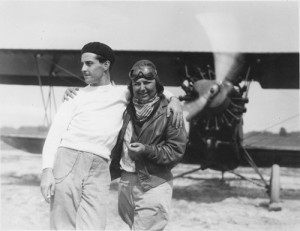
Pancho Barnes kept company with silent film star and heartbreaker Ramón Novarro. Other Hollywood friends included Erich Von Stroheim, William Boyd “Hopalong Cassidy” & Duncan Reynaldo “The Cisco Kid”.
The filmmakers are also considering creating a longer and richer cut of the film to take to national and international film festivals. Simultaneously, they’re still looking for matching sponsors to help fund the final stages of the film and its subsequent premieres. So far, the production has raised more than $100,000 in grants from benefactors that include the Allen Airways Flying Museum, the Bill Anders Foundation and the Clay Lacy Foundation.
“It’s not always easy,” Spark said of funding challenges. “Pancho Barnes is not Amelia Earhart. She’s controversial. The FBI investigated her and she had a big mouth. People still talk about the goings-on at the Happy Bottom Riding Club to this day. It’s a sensational story. At the same time, the journey is the fun part. It will be great to see it finished, but we’re having an incredible time making the film.”
For now, the filmmakers will finish creating the definitive film documentary on the life of “Our Aviatrix.”
“Her story encapsulates the history of aviation in the 20th century,” Spark said in summing up Barnes’ remarkable story. “Her grandfather started out as a balloonist during the Civil War. At 9 years old, she went with her grandfather to the Dominguez Air Meet of 1910, the first in the history of the United States. She was a barnstormer with the Mystery Circus of the Air in the 1920s. Then she was a stunt pilot, then a regular fixture at Edwards for the early jet era. I think people will finally recognize that Pancho Barnes had a formidable aviation career long before the Happy Bottom Riding Club came around.”
For more information on “Pancho Barnes!” visit [http://www.panchobarnesfilm.com]. Pancho Barnes’ official home page is [http://www.panchobarnes.com].











